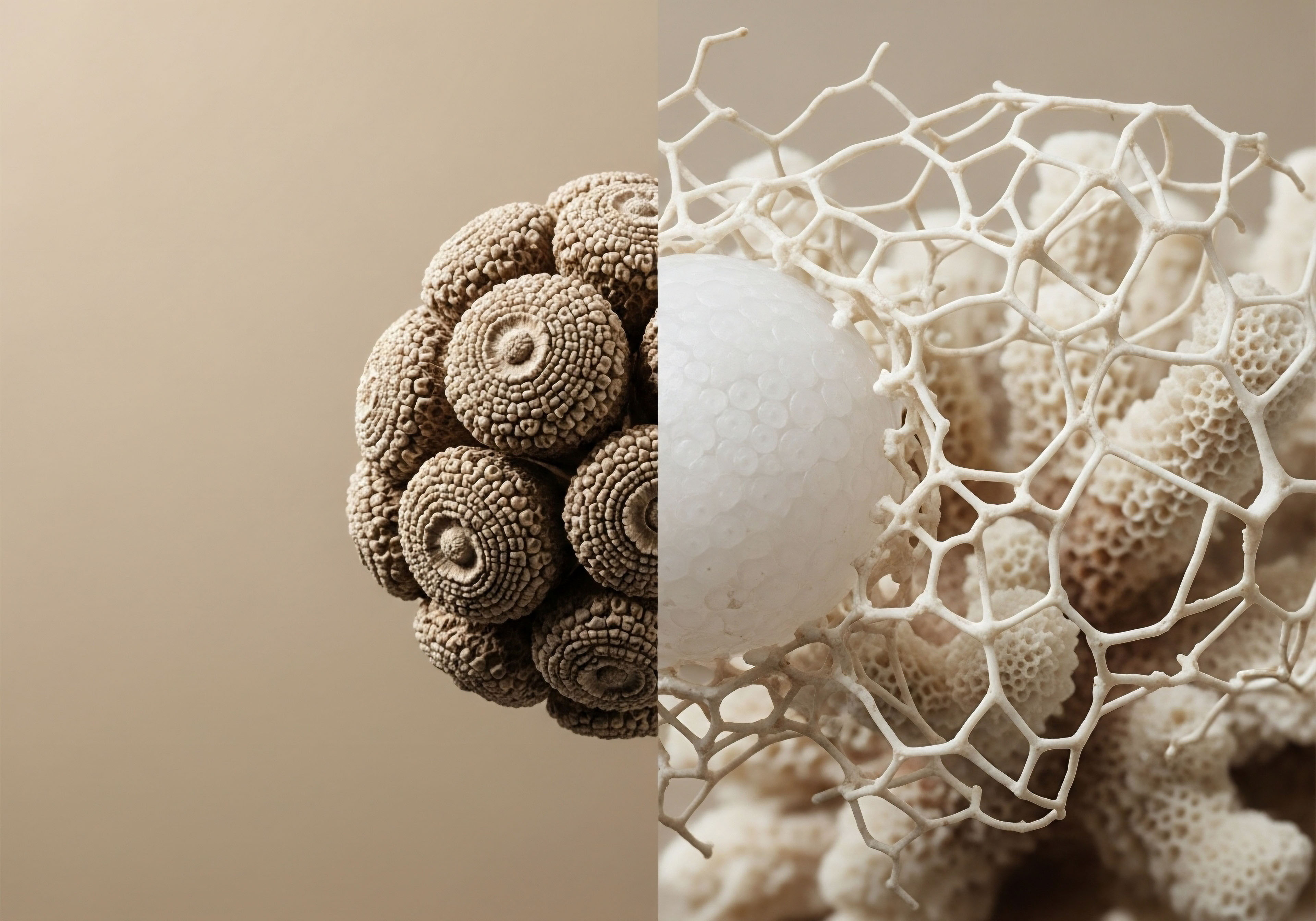

Fundamentals
Experiencing shifts in your vitality, a subtle yet persistent dimming of your internal light, can be disorienting. Perhaps you have noticed a decline in your usual vigor, a change in your body composition, or a quiet alteration in your mood. These sensations are not merely subjective; they are often the body’s way of communicating a deeper physiological recalibration.
When considering how the body recovers natural testosterone production after therapy, we are not just discussing a biochemical process; we are exploring a pathway to reclaiming a sense of self and function that may have felt compromised. Understanding the intricate biological systems at play offers a profound sense of agency, allowing you to partner with your own physiology on a journey toward renewed well-being.
The human endocrine system operates as a sophisticated internal messaging service, with hormones acting as chemical couriers. Testosterone, a primary androgen, plays a significant role in both male and female physiology, influencing muscle mass, bone density, red blood cell production, mood, and sexual function.
When exogenous testosterone is introduced, as in testosterone replacement therapy (TRT), the body’s internal thermostat, designed to maintain hormonal balance, registers an abundance of this hormone. This leads to a natural, adaptive response within the hypothalamic-pituitary-gonadal (HPG) axis, the central command system for endogenous testosterone synthesis.

The Hypothalamic-Pituitary-Gonadal Axis
The HPG axis functions as a finely tuned feedback loop, orchestrating the production of sex hormones. It begins in the hypothalamus, a region of the brain that releases gonadotropin-releasing hormone (GnRH). GnRH then signals the pituitary gland, located at the base of the brain, to secrete two crucial hormones ∞ luteinizing hormone (LH) and follicle-stimulating hormone (FSH).
In males, LH stimulates the Leydig cells in the testes to produce testosterone, while FSH supports sperm production. In females, LH and FSH regulate ovarian function, including estrogen and progesterone synthesis, and also influence ovarian testosterone production.
The HPG axis acts as the body’s central control system for natural testosterone production, responding to hormonal signals to maintain balance.
When external testosterone is administered, the hypothalamus and pituitary gland detect elevated testosterone levels in the bloodstream. This detection triggers a negative feedback mechanism, akin to a home’s heating system turning off when the desired temperature is reached. The hypothalamus reduces its GnRH output, and the pituitary gland consequently decreases its secretion of LH and FSH.
This suppression of LH and FSH directly reduces the stimulation of the testes (or ovaries in females, though the impact on ovarian testosterone is less pronounced with typical TRT doses) to produce their own testosterone. The longer and higher the dose of exogenous testosterone, the more pronounced this suppression becomes, leading to a state where the body’s intrinsic production capacity becomes dormant.

Understanding Hormonal Suppression
The suppression of the HPG axis is a predictable physiological consequence of exogenous testosterone administration. It is not a sign of failure, but rather the body’s intelligent system adapting to an external supply. For individuals undergoing TRT, this suppression is often a desired outcome, particularly if the goal is to alleviate symptoms of low testosterone without concern for fertility.
However, for those who wish to discontinue therapy or restore fertility, understanding this suppressive effect becomes paramount. The recovery process involves reactivating these dormant pathways, coaxing the body’s internal messaging system back into full operation.
The duration and dosage of testosterone therapy significantly influence the degree and ease of HPG axis recovery. Shorter durations and lower doses generally correlate with a quicker return to endogenous production. Conversely, prolonged therapy at higher doses can lead to more significant and persistent suppression, requiring a more structured and potentially longer recovery protocol. The body’s ability to recover is also influenced by individual factors such as age, overall health, and the underlying cause of the initial low testosterone.


Intermediate
Transitioning away from exogenous testosterone therapy, whether for fertility considerations or personal preference, requires a strategic approach to reactivate the body’s intrinsic hormonal machinery. This process, often termed a post-TRT protocol or fertility-stimulating protocol, involves specific pharmacological agents designed to stimulate the HPG axis.
The aim is to gently nudge the hypothalamus and pituitary back into their natural rhythm, encouraging the testes to resume their testosterone-producing function. This is not a simple cessation of therapy; it is a carefully orchestrated biochemical recalibration.

Agents for Endogenous Testosterone Restoration
Several medications are employed to facilitate the recovery of natural testosterone production. Each agent targets a specific point within the HPG axis, working synergistically to overcome the suppression induced by prior therapy. The selection and dosing of these agents are highly individualized, contingent upon the duration of prior therapy, the degree of HPG axis suppression, and the patient’s specific goals.
Here are the primary agents used in post-TRT recovery protocols:
- Gonadorelin ∞ This synthetic peptide mimics the action of natural GnRH, stimulating the pituitary gland to release LH and FSH. Administered via subcutaneous injections, typically twice weekly, Gonadorelin directly addresses the pituitary suppression, signaling it to resume its crucial role in the HPG axis. By providing a pulsatile GnRH signal, it helps to re-establish the natural rhythm of gonadotropin release, which is vital for testicular function.
- Tamoxifen ∞ A selective estrogen receptor modulator (SERM), Tamoxifen blocks estrogen’s negative feedback on the hypothalamus and pituitary. Estrogen, derived from testosterone via the aromatase enzyme, normally signals the brain to reduce LH and FSH production. By blocking these estrogen receptors, Tamoxifen effectively “tricks” the brain into perceiving lower estrogen levels, thereby increasing GnRH, LH, and FSH secretion. This leads to enhanced testicular stimulation and testosterone production.
- Clomid (Clomiphene Citrate) ∞ Similar to Tamoxifen, Clomid is also a SERM. It acts primarily at the hypothalamus and pituitary, competitively binding to estrogen receptors. This binding prevents estrogen from exerting its negative feedback, resulting in increased pulsatile GnRH release from the hypothalamus and subsequent elevation of LH and FSH from the pituitary. Clomid is widely used to stimulate endogenous testosterone production and improve sperm parameters.
- Anastrozole ∞ An aromatase inhibitor, Anastrozole reduces the conversion of testosterone into estrogen. While estrogen is essential for certain physiological functions, excessive levels can contribute to HPG axis suppression and side effects like gynecomastia. By lowering estrogen levels, Anastrozole can indirectly support testosterone recovery by reducing estrogen’s negative feedback, particularly when used in conjunction with SERMs or Gonadorelin. It is typically administered as an oral tablet, often twice weekly.
Post-TRT recovery protocols utilize specific agents like Gonadorelin, Tamoxifen, and Clomid to reawaken the body’s natural testosterone production pathways.

Tailoring the Recovery Protocol
A successful recovery protocol is not a one-size-fits-all solution. It requires careful monitoring of hormonal markers and a responsive adjustment of dosages. Initial assessments typically include baseline measurements of total testosterone, free testosterone, LH, FSH, and estradiol. These markers provide a roadmap for understanding the degree of suppression and tracking progress during the recovery phase.
Consider a typical post-TRT protocol for men aiming to restore fertility and natural testosterone production:
| Medication | Mechanism of Action | Typical Administration | Primary Goal |
|---|---|---|---|
| Gonadorelin | Mimics GnRH, stimulating pituitary LH/FSH release | 2x/week subcutaneous injection | Direct pituitary stimulation, re-establishing pulsatility |
| Tamoxifen | Blocks estrogen negative feedback at hypothalamus/pituitary | Daily oral tablet | Increases LH/FSH, boosts testicular testosterone |
| Clomid | Blocks estrogen negative feedback at hypothalamus/pituitary | Daily oral tablet | Increases LH/FSH, boosts testicular testosterone and spermatogenesis |
| Anastrozole | Inhibits testosterone-to-estrogen conversion | 2x/week oral tablet (optional) | Manages estrogen levels, indirectly supports HPG axis |
The duration of these protocols varies, often spanning several months to a year, depending on the individual’s response and the extent of prior HPG axis suppression. Regular blood work is essential to monitor hormone levels and adjust the protocol as needed.
The goal is to achieve a sustainable level of endogenous testosterone production, along with restored fertility if that is a patient’s objective. This systematic approach allows for a controlled and supported transition, minimizing the potential for symptoms associated with a sudden drop in testosterone.


Academic
The recovery of natural testosterone production following exogenous therapy represents a complex interplay of neuroendocrine signaling, cellular adaptation, and receptor dynamics within the HPG axis. Moving beyond the foundational understanding, a deeper exploration reveals the molecular intricacies that govern this physiological recalibration. The challenge lies not merely in stimulating hormone release, but in restoring the delicate pulsatile rhythm and sensitivity of the entire system.

Neuroendocrine Re-Patterning of the HPG Axis
The pulsatile secretion of GnRH from the hypothalamus is the fundamental driver of the HPG axis. Exogenous testosterone profoundly suppresses this pulsatility, leading to a desensitization of GnRH receptors on pituitary gonadotrophs and a reduction in the synthesis and storage of LH and FSH. The recovery process necessitates a re-patterning of this neuroendocrine rhythm.
Gonadorelin, as a synthetic GnRH analog, directly provides this pulsatile stimulus, aiming to re-sensitize pituitary receptors and re-establish the physiological release patterns of LH and FSH. The frequency and amplitude of GnRH pulses are critical; too frequent or too constant stimulation can lead to desensitization, while an appropriate pulsatile delivery can restore responsiveness.
The pituitary gland’s capacity to synthesize and release LH and FSH is also compromised during prolonged suppression. The gonadotroph cells within the pituitary undergo morphological and functional changes, including a reduction in mRNA expression for LH and FSH subunits. SERMs like Tamoxifen and Clomiphene citrate act by competitively binding to estrogen receptors in the hypothalamus and pituitary.
This blockade alleviates the negative feedback exerted by circulating estrogens, which are often elevated due to aromatization of exogenous testosterone or intrinsic production. By removing this inhibitory brake, the pituitary is disinhibited, leading to an upregulation of GnRH receptor expression and an increase in LH and FSH synthesis and secretion. The specific binding affinities and half-lives of these SERMs contribute to their distinct clinical profiles in stimulating gonadotropin release.
Restoring natural testosterone production after therapy involves intricate neuroendocrine re-patterning and cellular re-sensitization within the HPG axis.

Cellular Adaptation and Testicular Responsiveness
Beyond the central neuroendocrine components, the Leydig cells within the testes also undergo adaptive changes during exogenous testosterone administration. Chronic suppression of LH stimulation leads to a reduction in Leydig cell number and function, including decreased expression of steroidogenic enzymes necessary for testosterone synthesis.
The recovery of testicular function is contingent upon renewed and sustained LH stimulation. LH binds to specific receptors on Leydig cells, activating intracellular signaling pathways, primarily the cyclic AMP (cAMP) pathway, which upregulates the expression of genes involved in cholesterol transport and steroidogenesis.
The time required for Leydig cell recovery can vary significantly among individuals. Factors such as the duration of suppression, age, and pre-existing testicular health influence the rate of cellular proliferation and enzyme activity restoration. While LH stimulation is paramount, the overall metabolic environment also plays a contributing role.
Chronic inflammation, insulin resistance, and oxidative stress can impede Leydig cell function and overall HPG axis recovery. Therefore, a holistic approach that addresses these systemic factors can support a more robust and sustained return to endogenous production.

How Do Metabolic Factors Influence Hormonal Recovery?
The endocrine system does not operate in isolation; it is deeply interconnected with metabolic function. Metabolic health, including insulin sensitivity, body composition, and inflammatory status, significantly impacts the efficiency of HPG axis recovery. For instance, obesity is associated with increased aromatase activity, leading to higher estrogen levels and greater suppression of LH and FSH. This can make recovery more challenging, as the body’s own estrogen production continues to exert negative feedback.
Consider the following metabolic considerations during testosterone recovery:
- Insulin Sensitivity ∞ Impaired insulin sensitivity can negatively affect Leydig cell function and reduce LH responsiveness. Improving insulin sensitivity through dietary interventions and physical activity can therefore support testicular recovery.
- Adiposity and Aromatase Activity ∞ Higher body fat percentage correlates with increased conversion of testosterone to estrogen via the aromatase enzyme, which is abundant in adipose tissue. Reducing adiposity can lower estrogen levels, thereby reducing negative feedback on the HPG axis and facilitating recovery.
- Inflammation ∞ Chronic low-grade inflammation, often associated with metabolic dysfunction, can directly impair testicular steroidogenesis and pituitary function. Addressing systemic inflammation through lifestyle modifications and targeted interventions can create a more conducive environment for hormonal restoration.
- Nutrient Status ∞ Specific micronutrients, such as zinc and vitamin D, are known to play roles in testosterone synthesis and HPG axis function. Ensuring adequate nutrient status can support the biochemical pathways involved in recovery.
The integration of pharmacological interventions with comprehensive lifestyle optimization creates a powerful synergy for promoting natural testosterone recovery. This systems-biology perspective acknowledges that true hormonal balance extends beyond isolated hormone levels, encompassing the entire physiological landscape.
| Hormone/Marker | Role in HPG Axis | Expected Trend During Recovery |
|---|---|---|
| GnRH | Hypothalamic signal to pituitary | Increased pulsatile release |
| LH | Pituitary signal to Leydig cells | Initial surge, then normalization |
| FSH | Pituitary signal for spermatogenesis | Initial surge, then normalization |
| Testosterone | Endogenous production from testes | Gradual increase towards baseline |
| Estradiol | Aromatized from testosterone, negative feedback | Fluctuates, managed by Anastrozole if used |
| SHBG | Binds testosterone, influences free levels | May decrease as endogenous production normalizes |
The journey to recover natural testosterone production is a testament to the body’s remarkable capacity for adaptation and self-regulation. It demands patience, precise clinical guidance, and a deep appreciation for the interconnectedness of all biological systems. The ultimate goal is not merely to achieve a number on a lab report, but to restore the underlying physiological resilience that supports sustained vitality and well-being.

References
- Hayes, F. J. et al. “Gonadotropin-releasing hormone pulse frequency and amplitude modulation of luteinizing hormone subunit messenger ribonucleic acids in the male rat.” Endocrinology, vol. 135, no. 5, 1994, pp. 1820-1826.
- Katz, D. J. et al. “Clomiphene citrate and testosterone replacement therapy for male hypogonadism.” Current Opinion in Urology, vol. 22, no. 6, 2012, pp. 517-522.
- Mazer, N. A. “Testosterone replacement therapy and prostate safety.” European Journal of Endocrinology, vol. 156, no. 4, 2007, pp. 379-388.
- Nieschlag, E. et al. “Testosterone deficiency ∞ a historical perspective.” Asian Journal of Andrology, vol. 17, no. 5, 2015, pp. 747-752.
- Rastrelli, G. et al. “Testosterone and metabolic syndrome ∞ a systematic review and meta-analysis.” Journal of Endocrinological Investigation, vol. 37, no. 3, 2014, pp. 209-221.
- Shabsigh, R. et al. “The role of testosterone in the treatment of metabolic syndrome and type 2 diabetes.” Journal of Sexual Medicine, vol. 8, no. 5, 2011, pp. 1282-1292.
- Spratt, D. I. et al. “Gonadotropin-releasing hormone pulse frequency and amplitude in men with hypogonadotropic hypogonadism.” Journal of Clinical Endocrinology & Metabolism, vol. 64, no. 5, 1987, pp. 1009-1014.
- Veldhuis, J. D. et al. “Mechanisms of pulsatile luteinizing hormone secretion in men.” Journal of Clinical Endocrinology & Metabolism, vol. 72, no. 1, 1991, pp. 122-130.
- Wiebe, H. G. et al. “Testosterone and its effects on the male reproductive system.” Journal of Andrology, vol. 28, no. 2, 2007, pp. 207-215.

Reflection
As you consider the intricate dance of hormones and the body’s remarkable capacity for self-regulation, reflect on your own biological systems. This knowledge is not merely academic; it is a lens through which to view your personal health journey. Understanding the mechanisms of hormonal recovery is the initial step, a foundational insight into the possibilities that lie ahead.
Your path to reclaiming vitality is unique, requiring not just information, but a partnership with knowledgeable guidance to tailor protocols to your specific needs. This exploration serves as an invitation to engage more deeply with your own physiology, to listen to its signals, and to pursue a future where optimal function and well-being are not just aspirations, but lived realities.



